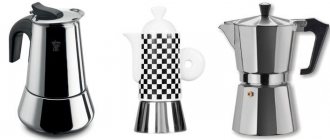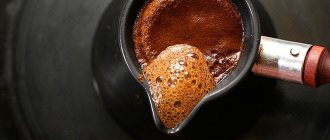The question of how to store ground coffee at home arises in two cases. When the grains are ground independently in greater quantities than required for preparing the drink. And when the vacuum packaging from the store is opened. Whole grains retain their flavor longer, so it's best to grind them just before cooking. Storing ground coffee has its own characteristics, which we will discuss further.
How long can coffee beans be stored at home?
Raw coffee beans last much longer.
As for coffee beans, be it Arabica, Robusta or other varieties, the shelf life is primarily affected by the degree of roasting. Raw grains retain their taste and aromatic qualities for quite a long time. Typically, the manufacturer designates a period of time as one year long, however, properly processed grains can be stored for about 3 years. Some varieties, subject to the necessary storage conditions, will remain suitable for up to 5 years, and this is the maximum period. True coffee connoisseurs will not allow themselves to purchase a product that is more than a year old.
It is worth remembering that the date on the packaging is not the date when the coffee beans were collected, but the date when they were packaged at the factory. Therefore, to be sure of the freshness of the grains, you can safely count the year from the date that is at least 1.5 - 2 months earlier than the date stamped on the packaging.
After heat treatment, the shelf life and quality are sharply reduced
After roasting, the shelf life of coffee at home is sharply reduced. This occurs due to the effect of temperature on the properties of grains. Heat treatment reveals a bouquet of essential oils, which give the drink a unique aroma with a slight bitterness. They evaporate quickly, so packaging is essential to preserve them.
- In an unsealed container, such as a jar or box, after opening, the grains will remain fresh for only 10-15 days, but, as a rule, this period is even shorter due to air humidity that is unsuitable for the grains.
- Foil will preserve the taste and aroma of a strong drink for up to a month.
- A special multi-layer sealed bag will ensure the preservation of coffee for up to 6 months, and when using an additional inner layer, where the base is polymer - up to 9 months.
- Packaging that requires thermal sealing and is equipped with a special valve to remove carbon dioxide will preserve the contents for a year.
- The best option for storing roasted beans is considered to be an opaque glass, ceramic or metal jar with an airtight lid, for example, like those of the Black Card, Illy brands; such packaging will allow you to enjoy fresh coffee even 18 months after packaging in production.
Glassware with opaque walls is best suited for storing beans.
Ground coffee is even more capricious: if you grind it at home, its shelf life is no more than 3 months. But over time, the taste and aroma of the drink will remain only a memory. Volatile compounds break down even more quickly than in whole roasted beans. And they are replaced by smells floating in the air. To maximize the freshness of ground coffee, you should immediately wrap it in foil, for example, like the packaging of the Lebo or Jardine brands, and put it in a dark, dry place. Another way is to place the powder in a ceramic bowl, cover tightly with a lid and put it in the refrigerator.
But leaving freshly ground coffee directly in the coffee grinder is not the best idea; in this form it will retain its properties for no more than 2 weeks. Experienced coffee lovers recommend grinding the beans in small quantities immediately before brewing, so that the taste and aroma of the drink will be most vivid.
It is best to store ground coffee in a foil package or in a tightly closed and opaque glass container.
As for factory grinding, it is done immediately before packaging and minimizes the loss of taste and aromatic qualities. The shelf life will again depend on the type of expiration date and place of packaging:
- Paper and polyethylene will preserve the product for 6-9 months.
- A bag with a foil layer will extend this period to 18 months.
But if the original packaging is violated, ground coffee will lose its properties within 2 weeks.
Storing green coffee
Raw coffee is cheaper than roasted coffee. Manufacturers usually indicate on the packaging the shelf life of green grains - 1-2 years. Green loose coffee will also not lose its properties during this time if it is poured into a hermetically sealed container or bag.
Green coffee should never be kept in the refrigerator or frozen in the freezer.
You can buy loose coffee only if it is fresh: all the beans are the same color, with a pleasant herbal smell and a matte velvety surface. The grain is easy to bite through and does not crumble. Such coffee in an airtight container is guaranteed not to lose its properties for 2 years.
But if the grains are of different colors and sizes, then they are most likely collected from the remains of several harvests. It is unknown how this coffee will behave when roasted. Old grains are too hard, almost devoid of smell, dried out at the edges, and crumble when bitten. It is better not to buy a large batch of old or uneven coffee, as it will quickly lose its taste and aroma. In general, you should not buy green beans with a musty, moldy smell: during roasting it will only worsen, and storing this coffee is out of the question.
The shelf life of high-quality green grains is up to 5, and some varieties – up to 8 years. In Arab countries they even believe that the taste of beans will improve if they are kept in bags for at least six months before roasting. However, in 5–8 years, the taste and aroma of coffee will most likely be gone. A drink made from very old grains is brewed only if you need to cheer yourself up, and there is no decent coffee at hand.
If green coffee has been stored so long that it has almost completely lost its taste and aroma (but has not become moldy or acquired a musty smell), it can be “restored” in one of two ways:
- fry until very dark. With strong heating, residual aromatic substances appear;
- fry with spices: cloves, cinnamon, anise. The coffee beans will be imbued with their aroma.
Shelf life and contents of instant coffee drink after opening the vacuum packaging
Instant coffee has a longer shelf life than natural coffee. Cooking technology using artificial additives makes it less organic, and therefore less susceptible to external factors. But even such a drink loses its properties over time: the smell becomes sour and the taste becomes musty.
Instant coffee is better preserved in its original packaging or container
If you store an instant drink in an airtight container or original packaging in a dry, dark place, it will remain in its original form for about 2 years. Some manufacturers boast a longer shelf life - up to 3 years.
Shelf life and shelf life of different types of coffee
| Type of coffee | Shelf life | Best before date |
| Green coffee | 1–2 years | 5 years |
| Roasted beans in packaging | 1–1.5 years | 2–3 years |
| Roasted beans without packaging | 2 weeks | 2–3 years |
| Ground coffee in packaging | 1–1.5 years | 2–3 years |
| Freshly ground coffee | 2 weeks | 2–3 years |
| Coffee capsules | 1–2 years | 5 years |
| Instant coffee | 2 years | 2 years |
How to properly store coffee at home
Truly delicious coffee can only be prepared from selected high-quality beans. The variety, blending, roasting, and most importantly, proper storage are important here. Compliance with certain conditions is the key to preserving the taste and aroma of this invigorating black drink.
Grains in a glass jar
The jar with beans is placed away from heating kitchen electrical appliances.
The best place to store coffee beans will be a hanging kitchen cabinet. Ideally, it is completely closed and made of natural material. An important condition is that the shelf with coffee beans should be located at least 4-5 meters from heating devices and at least a meter from the floor. The “neighbors” of the grains will also have to choose calm ones - it is better if they are cereals or pasta. But it’s better to keep the spices away, otherwise the beans will absorb the aromas of the spices.
After opening the package, the grains should be poured into a glass jar with a tight-fitting lid; darkened glass would be best. But after being in a tin or metal can, the coffee will have a metallic taste.
Ground
After grinding, coffee becomes more demanding on storage conditions, so the rules are somewhat specific. Although the general recommendations coincide with the grain version.
If you don’t have a vacuum sealer at home that allows you to extract air from a bag of coffee, then the best option would be to store it in the original pack.
It protects the powder from exposure to light, moisture and foreign odors. In addition, it is created in such a way that condensation does not form inside and the coffee does not become damp. If the opened package does not have a reusable lock, it is necessary to release as much air as possible and tightly twist the edge of the package, securing it with a special clip or a regular stationery clip.
Soluble in tin packaging
The container with the instant drink is placed in a dry, cool and dark place.
The main enemies of the instant drink are dampness and temperature changes. Because of them, the product will quickly gather in lumps and lose the aromatic substances remaining after processing in production. Dry air and a dark place will preserve the taste characteristics of instant coffee.
If you need to store an open pack for a long time, it is better to wrap it in foil, and in the case of a jar, place a piece of foil between the lid and the container itself. If for some reason the package is opened and the coffee has lost its aroma, you can put a cinnamon stick inside and close the bag tightly, after a few days the coffee will again have the same smell as before.
What can happen if stored incorrectly
If stored improperly, the characteristics for which everyone loves the invigorating drink inevitably deteriorate:
- in air, the grains oxidize and change or lose their taste;
- the aroma disappears because the aroma compounds are unstable;
- the foam becomes thin and unstable as the grain structure becomes denser;
- coffee absorbs moisture - the taste deteriorates and mold appears;
- with simultaneous dampening and oxidation, the grains decompose;
- Coffee absorbs surrounding odors.
However, what is more important is that if storage conditions are violated, the product can become hazardous to health. If it becomes damp and covered with mold, you cannot brew the drink - you can get poisoned. If the coffee beans smell like rancid fat, this indicates spoiled oils, which are harmful to the liver.
- Don't miss: The benefits and harms of coffee beans
What kind of coffee can be stored for a long period
For a long-term supply, you should give preference when purchasing green beans.
If you plan to store coffee for a long time, and you need to purchase quite a large amount, then raw green beans will be the best option. Their undoubted advantage is their low cost compared to roasted and ground grains. In addition, they are the least demanding on storage conditions, since the aromatic substances are securely contained inside. In this regard, the main requirement is a constant temperature not exceeding 20 degrees. Optimal humidity is also necessary, otherwise the grains will become damp and begin to mold.
An excellent place for storage would be a kitchen cabinet or niche away from heating appliances in bright sunlight.
If the bag of grains is quite voluminous, you should cut its corner without damaging the rest of the package. Having poured the required amount, the cut must be tightly twisted and secured, for example, with a paper clip.
The convenience of buying a large supply of raw coffee beans is that you have a fresh drink at hand at any time: you just need to roast and grind a small handful of beans. At the same time, the coffee will have a deep taste and rich aroma, because the time between heat treatment and brewing of the drink is minimal.
Recommendations for storing in the refrigerator and freezer
The freezer is one of the possible places to store coffee beans. They can be either raw or fried. Moreover, in the second case, freezing should be “shock” and carried out immediately after heat treatment.
One of the options for long-term storage is the freezer.
It is not worth storing a large number of grains in one package at once. In this case, every time you want to drink a cup of coffee, you will have to remove the beans from the cold and keep them warm for a while, then return them back to the freezer shelf. Such temperature changes will turn the grains into a tasteless and odorless product within a couple of months.
It is better to package them in small portions and defrost as needed. It is very important, after the grains are warm, to allow them to thaw on their own: you should not heat them in the microwave or place them near heating appliances. Grinding half-frozen beans is also not a good idea. The optimal temperature for grains ready for further processing and grinding is 15 degrees.
It is better to freeze in small portions; before grinding the grains, you need to defrost them completely.
Even in a frozen state, grains are extremely susceptible to odors, so products with a strong odor, such as fish, meat, seafood, etc., should be kept as far away as possible, otherwise an off-flavor in the finished drink cannot be avoided.
The difference between a good product and a bad one
The main criterion that suggests that coffee has gone bad is the smell. Externally, the grain, ground or instant drink changes little over time. But the aroma, on the contrary, can either disappear completely or become rancid or sour. The difference in taste is also not always noticeable; moreover, drinking an expired drink in most cases is not dangerous, especially if we are talking about raw beans, and it even retains an invigorating effect due to the caffeine content.
Grain
A sign of marriage is empty and brittle beans.
In addition to the obvious damage to the appearance of unroasted beans: mold, sour or musty smell and dried edges, a stale product shows a lack of taste and aroma after roasting. The grains are brittle and empty inside. With high humidity, on the contrary, rotten beans may appear in the bag.
But heat-treated ones, on the contrary, only harden over time and are difficult to grind. They acquire too dark a color due to the oxidation of oily substances, which also give stale grains a rancid smell. In addition, such grains shine unnaturally and stick together.
Coffee beans affected by pests
If it’s a pity to part with roasted coffee beans that have lain idle for a long time and have lost their freshness and aroma, you can use them to decorate interior items: photo frames, coasters, flower pots, flower vases, etc. This will give ordinary items an interesting twist, and the grains will not go to waste.
Ground
Spoiled ground coffee has a lumpy consistency.
Stale powder will have a non-uniform consistency - lumps in the packaging arise due to long-term storage at high humidity, in addition, the coffee can “melt” and solidify into a single solid mass. It is especially unpleasant if there are any living creatures in the ground drink; this type of coffee is the most suitable for the reproduction of unpleasant creatures.
As for the smell, it is either absent in the stale powder or acquires shades of what the coffee was stored next to.
Soluble
The most resistant type of coffee drink to changes over time. Obvious signs of an expired product are traces of mold and mildew.
Clumping and caking of the granules will also indicate that the shelf life has expired. The smell of stale instant coffee becomes sour or is completely lost. But unpleasant living creatures are found in it extremely rarely, this is due to the peculiarities of production: the low content of essential oils and chemical additives repel parasites.
There is mold and cobwebs in the packaging
Currently, there are no cases of poisoning from stale coffee. However, this does not mean that it can be stored carelessly and for a long time. As with any organic product, toxins accumulate and chemical reactions occur. Of course, one cup of such a drink will not do much harm, but systematic use can lead to problems with digestion and liver. In addition, you should not expect pleasant sensations from spoiled coffee: a faded taste with a sour or bitter aftertaste, the absence of a tart aroma and the loss of an invigorating effect are clearly not what coffee lovers expect.











